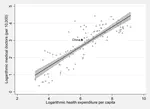 Photo by CTang
Photo by CTang
The Law for Licensing Medical Practitioners of the People’s Republic of China, enacted in 1999, was amended in 2021. This commentary reviews the key points of the amendment and raises doubts as to one of its points. Specifically, we argue that the minimum education level required to take the physicians’ licensing examination should be set to completion of a bachelor degree, instead of a vocational diploma or junior college graduation as in the 2021 amendment. China adopted a system of multi-tiered medical education more than 70 years ago. This policy has resulted in a threshold of entry-level medical education far below the global standards. The highly heterogeneous education background of physicians in China has led to low standards of practicing physicians, which in turn have significantly negative impacts on the health care market. We illustrate changes over time in the educational distribution and regional distribution of practicing physicians in China, and present reasons to improve entry-level educational standards, by setting the physician licensing threshold at an appropriate level. This will not only improve the overall quality of physicians but will also help address equity and efficiency issues in the health care market.

